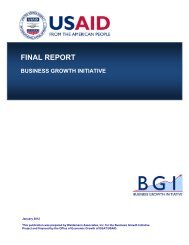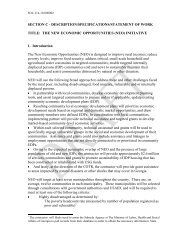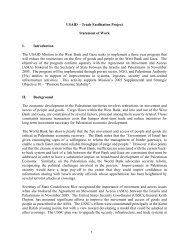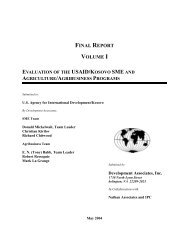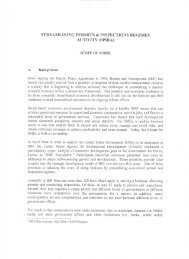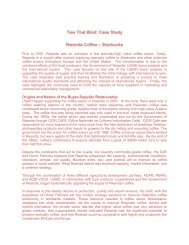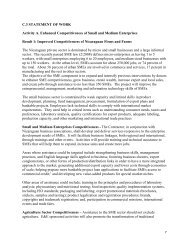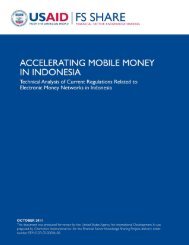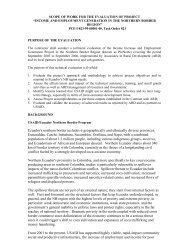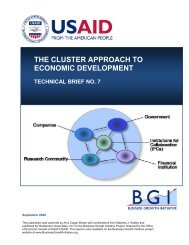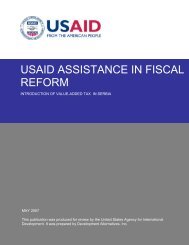Property Tax Reform in Developing and Transition Countries
Property Tax Reform in Developing and Transition Countries
Property Tax Reform in Developing and Transition Countries
Create successful ePaper yourself
Turn your PDF publications into a flip-book with our unique Google optimized e-Paper software.
Other well-meant attempts to make the property tax more progressive may be less successful. One such<br />
approach is to provide tax preferences to pensioners. However, not all retirees are poor, <strong>and</strong> without an<br />
<strong>in</strong>come test, the net for this preferential treatment is likely to capture many of the non-poor. Another<br />
approach, practiced <strong>in</strong> Southeast Europe, is to <strong>in</strong>crease the property tax exemption for larger family sizes.<br />
For example, <strong>in</strong> Serbia, owner-occupiers receive a 40 percent reduction <strong>in</strong> taxes, <strong>and</strong> this is <strong>in</strong>creased 10<br />
percent for every member of the household up to a limit of 70 percent (Begovic, 2004). Yet a larger<br />
family size by itself does not necessarily signal that the property tax is less affordable; <strong>and</strong> besides,<br />
monitor<strong>in</strong>g such a provision is extremely difficult.<br />
Third, there are the “social eng<strong>in</strong>eer<strong>in</strong>g” exemptions, <strong>and</strong> those given for political reasons. Chief among<br />
these is the owner-occupier exemption, which is used <strong>in</strong> nearly all countries. It may be politically popular,<br />
but it is regressive <strong>in</strong> its impact <strong>and</strong> imposes a significant tax expenditure on local budgets. Moreover, the<br />
owner-occupier exemption <strong>in</strong>creases adm<strong>in</strong>istrative costs because it requires classification of every parcel<br />
<strong>in</strong> terms of tenure, <strong>and</strong> it usually requires the application of differential nom<strong>in</strong>al tax rates or differential<br />
assessment rates. Whether the owner-occupancy exemption achieves the social purpose of encourag<strong>in</strong>g<br />
homeownership is debatable at best. Whether it achieves the political goal of ga<strong>in</strong><strong>in</strong>g favor with owneroccupiers<br />
is less debatable. Some countries go even further. Residential property is not taxed at all <strong>in</strong><br />
Central <strong>and</strong> Eastern European countries like Latvia <strong>and</strong> Lithuania, an exclusion that narrows the tax base<br />
considerably.<br />
A fourth class is the exemption from property taxation of government-owned properties, <strong>and</strong> properties<br />
occupied by nonprofit enterprises. This exemption deprives local governments of the right to charge for<br />
some of the l<strong>and</strong> use with<strong>in</strong> their boundaries <strong>and</strong> it imposes a revenue cost. The considerable services<br />
provided to those properties are, therefore, not compensated by the users (Bahl <strong>and</strong> L<strong>in</strong>n, 1992, p. 100).<br />
Mathur, et. al. (2009) estimate that the revenue cost of exempt<strong>in</strong>g government property is equivalent to<br />
about 12 percent of collections <strong>in</strong> India’s 36 largest cities.<br />
How do develop<strong>in</strong>g <strong>and</strong> transition countries def<strong>in</strong>e a “best practice” with respect to exemption policy<br />
Three steps might be taken.<br />
First, <strong>in</strong>stitute a periodic review of property tax exemption policy with the goal of determ<strong>in</strong><strong>in</strong>g whether<br />
exemptions cont<strong>in</strong>ue to serve their <strong>in</strong>tended purpose. Place a moratorium on any new preferential<br />
treatments, <strong>and</strong> <strong>in</strong>troduce a sunset for all exist<strong>in</strong>g preferential treatments, or at least a time period for their<br />
review.<br />
Second, adopt the practice of valu<strong>in</strong>g all property, <strong>in</strong>clud<strong>in</strong>g that which is exempt, on an annual basis.<br />
Use this <strong>in</strong>formation to prepare an annual tax expenditure budget for the property tax, identify<strong>in</strong>g all<br />
property tax revenues foregone by exemptions <strong>and</strong> reliefs.<br />
Third, <strong>and</strong> based on this valuation determ<strong>in</strong>ed by the tax expenditure budget, charge a payment <strong>in</strong> lieu of<br />
property tax for government properties <strong>and</strong> for most not for profit uses of property. Such a practice is<br />
followed <strong>in</strong> many countries, <strong>in</strong>clud<strong>in</strong>g, for example, India <strong>and</strong> Kenya. In Mumbai, the payment <strong>in</strong> lieu is<br />
set at 80 percent of the tax that would have been paid if the property was privately owned (Tata Institute<br />
<strong>and</strong> University of Mumbai, 2001). 12<br />
12 In Canada, it is the federal government, <strong>and</strong> not the tax<strong>in</strong>g authority, which determ<strong>in</strong>es the values <strong>and</strong> rates to be<br />
used <strong>in</strong> the payment <strong>in</strong> lieu calculation with respect to federal property.<br />
15



